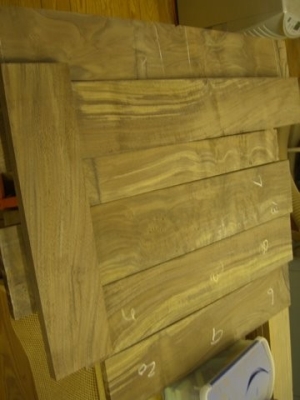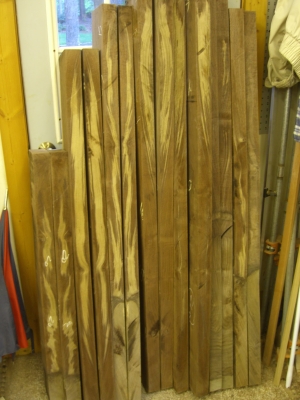Question
I'm encountering some problems drying claro walnut. A customer brought me about 500 bd ft to be dried. Some of this wood was previously dried by anther kiln operator (who knows his business and has a great reputation, but like me is not familiar with claro). Some of it had not been through a kiln, but air dried for several months.
I use a Nyle L200 kiln unit. The bulk of the customer's wood is 8/4, with a couple of 12/4 pieces. He also brought me about 300 bd ft of black walnut, also 8/4. The customer's wood initially measured between 20 - 30% MC (both claro and BW). After several weeks in the kiln at 120F and 40% RH, the MC% in the claro wood varied between 6 - 20% - in the same board! Some of the claro boards had a graft line, and in these boards the English walnut above the graft line also came out consistently in the 6 - 8% range.
The black walnut - which was interspersed in the same stacks as the claro in the same load - came out uniformly between 6 - 8% MC. After a couple of weeks with varying results, we unloaded the kiln and the customer planed down the claro to find yellow streaks throughout the wood. These streaks corresponded with where there was higher MC%. (See photo - the yellow streaks are not sapwood). Interestingly enough, the yellow wood is buried in the boards; the surface is a uniform brown color. It is only after planing the surface off that the yellow wood is exposed.
The kiln stacks were all measured with an anemometer for proper air flow, and my equipment is working properly. Is this a common problem when drying claro walnut? Are there any special techniques that I should follow in order to successfully dry this wood?

You can see where the yellow streaks are embedded in the wood - primarily in the center of the boards.

Forum Responses
(Sawing and Drying Forum)
From Professor Gene Wengert, forum technical advisor:
If the yellow color is in the heartwood, it will darken with exposure to air and light.
The moisture problem is called a water pocket, wetwood, or bacterial wetwood. The high moisture is more common with thicker stock. The cause is a bacterial infection in the tree. It cannot be fixed, so drying must be very slow. In fact, air drying for 6 months or more is suggested. Avoid sawing 8/4 and thicker from such logs. After drying, it is common to find cracks in this wood, as it is weaker than normal. If you use the wood before it is dried, then the moisture will leave eventually and the wood will shrink at that time.
Comment from contributor S:
I understand this to be trapped moisture as a result of case hardening. This happens when the lumber has been dried too fast. It will turn to the regular color after a while. Walnut needs to have a slow and steady means of drying. If it is exposed to high heat or just thrown in the kiln too fast case hardening will result.